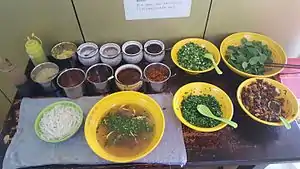 | |
| Type | Chinese noodles |
|---|---|
| Place of origin | China |
| Region or state | Yunnan |
| Main ingredients | Non-glutinous rice |
| Variations | Ganjiang mixian, suanjiang mixian |

Mixian (simplified Chinese: 米线; traditional Chinese: 米線; pinyin: mǐxiàn) is a type of rice noodle from the Yunnan Province, China. It is made from ordinary non-glutinous rice, and it is generally sold fresh rather than dried.[1]
Production
The processing of mixian in Yunnan is unique, involving a fermentation process. In many areas there are at least two distinct thicknesses produced, a thinner form (roughly 1.5 mm or 0.059 inches in diameter) and a thicker form (roughly 3.5–4 mm or 0.14–0.16 inches in diameter).
Serving
Mixian is served in various ways, either in broth or stir-fried.
Stir-fried
Stir-fried preparation is rapid, most common in the evening, and is popular at roadside barbecue-type stands throughout Yunnan. Egg, tomato, meat, spring onion and chilli are frequently utilized.
Broth

Condiments vary significantly but may typically include some subset of the following:
- chicken powder or essence
- chili pepper (diced fresh chili, plus at least one or two prepared chilli pastes, often mixed with oil)
- chrysanthemum flowers
- coriander
- mint
- garlic (often finely diced, in liquid suspension, or in thin sectioned slices)
- ginger (as above, but less commonly in slices)
- pepper (both regular pepper and powdered or whole Sichuan pepper)
- salt
- sesame oil
- Sichuan pepper oil
- soy sauce
- spring onion
- suan cai (pickled or preserved vegetable)
- tomato
- vinegar
- wood ear mushroom
- zhe'ergen (a spicy root common to southwestern China).
Geographical extent
Mixian is popular in Yunnan Province, where it can be found in many streets and villages, and is occasionally available in other mainland Chinese cities. It is generally very difficult to obtain outside of mainland China, probably since the fresh method of preparation could be seen to necessitate a certain minimum volume of consumption in order to be commercially viable. It is relatively similar to noodles consumed in neighbouring Laos (feu) and Vietnam (phở), with the key difference that the base mixian broth is usually heavily personalized by the customer in Yunnanese tradition, and the establishment's own pre-made broth is less adulterated and more significantly appreciated/judged as a key factor in Vietnam (and perhaps to a lesser extent Laos). Dishes like nan gyi thohk and baik kut kyee kaik in various parts of Myanmar are based on a similar dimension of rice noodle but differ broadly in flavour profile (tending more toward flavours in Indian cuisine with ingredients such as chickpea flour) and preparatory method (far greater use of frying). It is more common in unadulterated Yunnanese form in commercial centers of Myanmar with growing Chinese populations, such as Mandalay. Dishes in Thailand such as pad thai also rely on rice noodles, though often they are flat and therefore more similar to Chinese juanfen or Yunnanese migan. A Tibetan broth-based noodle dish using wheat-flour instead of rice-flour noodles, thukpa, is thought to have originated in eastern Tibet (i.e. closer to Yunnan) and is made and enjoyed throughout Bhutan, Northeast India, Nepal, Sikkim and Tibet.
See also
- Migan (noodle)
- Rice, History of domestication and cultivation
- Yunnan cuisine
- Khanom chin, a Thai fermented-rice noodle
References
- ↑ Christina, Izzo (3 February 2018). "Move Over, Ramen! Mixian is the New Noodle on the Block". Rachael Ray Magazine. Retrieved 30 May 2020.